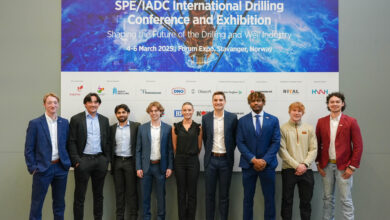Technical Session 3 – Cementing & Zonal Isolation
Editor’s note: These abstracts have been edited for space and clarity. This program is current as of 15 January 2013. Additions, withdrawals and other changes to the conference program after this date may not be reflected. Click here for the most updated program.
TECHNICAL SESSION 3: CEMENTING AND ZONAL ISOLATION
SPE/IADC 163482
Sakhalin Gas Shut-off Workovers: A Case History of Zonal Isolation at Record Depths, R. Molloy, ExxonMobil Development Company; M.M. DiPippo, Exxon Neftegas
Exxon Neftegas, as operator for the Sakhalin-1 project, recently completed gas shut-off workovers on two extended-reach horizontal wells at the Chayvo field, Sakhalin Island, Russia.
This paper will recap the results of this successful gas shut-off workover campaign and the learnings obtained from straddle liner installations at world record depths.
SPE/IADC 163426
Innovative Managed Pressure Cementing Operations in Deepwater and Deep Well Conditions, Y.A. Elmarsafawi, A. Beggah, Schlumberger; V. Pradet, C. Cheshier, BP
In Shah Deniz field in the Caspian Sea, the innovative MPD cementing technique was used to cement several string sizes that sat at different depths. In this challenging deepwater environment, specialized surface equipment was used to control the well during cementing. In addition, the mud properties and cement system were tailored for this specific operation. After cementing, the job was evaluated with sonic and ultrasonic logging tools.
The success of the MPD cementing technique enabled us to reduce completion costs and achieve drilling objectives. In this paper, we present case studies of the technique used to cement several wells and the evaluation performed after operation completion.
SPE/IADC 163452
HPHT Well Construction with Closed-Loop Cementing Technology, D.M. Hannegan, Weatherford International
This presentation speaks to applying the principals of MPD and recent refinements of its deepwater practice to cementing processes. Precise mass flow in/out measurements, ascertainment of actual downhole pressure environment, ability to conduct frequent dynamic formation integrity tests without drilling interruption and use of PLC choke systems are applicable strengths.
SPE/IADC 163511
Qualification and Field Trial of a Metal Expandable Well Annular Barrier, J.R. Drechsler, O. Eikeskog, Statoil; P. Hazel, R. Vasquez, B. Filev, Welltec A/S; O. Hjorteland, Welltec Inc
This paper covers the design, development and qualification of a hydraulically expandable metal annular barrier assembled on a full bore liner. The presentation will review the design, material selection to achieve the required expansion, the unique outer seal design to deliver the pressure differential requirements and the final qualification process, which exceeds the industry- established guidelines within ISO 14310.
SPE/IADC 163461
LWD Sonic Cement Logging: Benefits, Applicability and Novel Uses for Assessing Well Integrity, M.P. Blyth, D. Hupp, T. Kinoshita, Schlumberger; I. Whyte, Tullow Oil
This paper explores the applicability of LWD sonic tools to the analysis of cement behind casing. It considers both the currently accepted deliverable of top of cement analysis, along with examples of more advanced processing techniques and their comparison to wireline cement evaluation, providing case study examples in each case.
The benefits and limitations of these methods will be discussed, along with operational considerations to aid in successful logging, including the use of repeat logging passes to indicate changes in cement quality with time. The use of LWD sonic tools to identify casing collar connections on driller’s depth, enabling the safe positioning of cased-hole whipstocks, is also covered, demonstrating a novel and little-used application of LWD technology.

SPE/IADC 163446
Accounting for Lost Circulation and NAF Compressibility – Impacts on Cement Placement, J.M. Shine, Jr., S.A. Chaudhary, A.J. Felio, R.S. Martin, Baker Hughes
This paper will explain the theory and methods behind the advanced cementing simulator inputs and resultant outputs with case histories demonstrating field validation of the new simulator’s reliability. For example, in a Gulf of Mexico well where zonal isolation below the base of salt is critical, the simulator provided more accurate results resulting in top of cement as planned. The advanced simulator provides accountability for new industry regulations and confidence when evaluating the cement placement.
E-POSTERS:
SPE/IADC 163544
Performance of Heavyweight Cements at Ultra-High Temperatures, J. Caritey, J.E. Brady, Schlumberger
The effect of common weighting agents on the corresponding set cement properties at very high temperatures and pressures is presented. It demonstrates for the first time that metal (iron, titanium, manganese) oxides are not at all inert in these conditions. Analytical data show that they react with cement hydrates (xonotlite) to form other mineral phases, which are detrimental to zonal isolation as they result in lower compressive strength and higher permeability. A new strategy for heavy weight cements at extreme temperature is then presented, where performance of the set cement is preserved.
SPE/IADC 163459
Dynamic Cementation: A Solution to Well Integrity Problems, C. Holt, N. Lahoti, L. Godoy, Tesco Corp
A new method of dynamic cementation, where pipe movement is maintained until cement begins to set maximizes the mud-cement displacement process. It can achieve a quality completion using cementing software, real-time rig instrumentation and casing rotation/reciprocation.
In this paper, barriers to change, a methodology with classifications in dynamic cementation levels and field examples are presented. It investigates the benefits of casing movement during cementing and reviewing cement bond logs.




